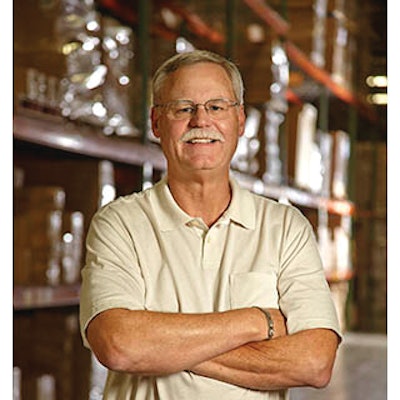
Do you have an extended supply chain with extreme seasonal variability? Does this situation challenge your ability to meet service level commitments to your customers?
For years, Rev A Shelf (RAS), a U.S. manufacturer of home storage accessory items, grappled with this situation caused by the Chinese New Year and other global events. The Chinese New Year drives the planet’s greatest annual population migration and can shut down production for up to two months. This created significant supply risk, impacting the company’s ability to meet a three-day order fulfillment commitment it makes to its customers.
This was a significant challenge since Rev A Shelf imports 60 percent of the parts it uses to build its products from China and Europe. Most of the year, it is able to plan its inventory needs using a spreadsheet-based minimum/maximum approach. But not during Chinese New Year!
Recognizing the Need for Change
Rev A Shelf, with headquarters in Jeffersontown, Ky., manufactures products that go inside kitchen cabinets, closets, bathroom vanities and more. Its distribution channels include 150 hardware distributors, kitchen cabinet original equipment manufacturers (OEMs), and the major home centers through special order or stocking programs.
About 10 years ago, as trends started to change in the kitchen industry and everyone was facing pricing pressures, Rev A Shelf began a product line diversification. It turned to China to reduce its manufacturing costs. Today, the company has 17 vendors in Asia, a fully staffed representative office in Hangzhou, China and RAS quality control (QC) personnel situated around the country with key vendors.
The company stocks 4,000 active parts, 60 percent of which are sourced in Asia and Europe. It imports approximately 850 containers a year. Typically, these parts have a 12-week lead time.
One of its big planning problems was that the fourth quarter was always slow, but the first quarter of the next year was always a big sales quarter. So, the company used an average calculated from a slow period to buy for its heaviest sales period. And with its spreadsheet-based minimum/maximum system, as lead times transitioned to 12 weeks, the calculated minimum stock ballooned.
“When you have lots of part numbers, and any sort of supply or demand variability, you just cannot forecast effectively with a spreadsheet,” said John Englehardt, director of purchasing and Asian operations at Rev A Shelf. “With our minimum/maximum forecasting system, we were planning to an average, and it wasn’t working. Average usage has inherent flaws for planning purposes—it’s always looking backward!”
Technology and Education Lead to Planning Success
Rev A Shelf solved its problem by introducing statistical demand forecasting with the flexibility to extend lead times when necessary, and establish reliable safety stocks that achieve its required service levels, along with implementing a continuous reporting system that provides actionable information and lets everyone know exactly where the company stands.
Looking for a solution, Rev A Shelf turned to SmartForecasts from Smart Software of Belmont, Mass. for a better way to plan for seasonality,and determine how much stock was needed.
SmartForecasts can provide accurate forecasts for a large percentage of parts that had hard-to-forecast intermittent demand. The new software’s patented technology accurately forecasts intermittent demand, and provides inventory managers with accurate estimates of the optimal inventory and safety stock required to meet future orders and achieve desired service levels over a replenishment lead time.
“SmartForecasts was very easy to implement and integrate with our corporate systems,” claimed Englehardt. “In fact, we were able to interface the software to our database system over a weekend.”
However, success required much more than a new piece of software.
Full implementation took about a year and a half due to internal considerations. Planners at Rev A Shelf knew that they had to make changes, but also acknowledged that there would likely be resistance. Senior managers, for example, developed a healthy distrust of software and wondered whether demand forecasting software could help. On the other hand, buyers developed their own perspectives and procurement methods, and might feel personally at risk using new approaches.
“Education was a big part of the solution,” said Englehardt. “We explained how forecasting works and key factors we should all understand: how to analyze trends, how to use what-if scenarios, the effects of inventory turns, the impact of lead times, how to analyze service levels, and the relationship between service level goals and inventory turns. People came around as they developed a common understanding of the problem and how we would address it.”
Englehardt also brought in an outside consultant, a professor from University of Louisville’s College of Business and a graduate student who used the project for his master’s thesis. Their independent work validated the efficacy of SmartForecasts’ results. The stakeholders at Rev A Shelf now feel confident in the forecasts and stocking recommendations it’s getting from SmartForecasts.
Planning for the Future
“There’s a difference now in our planning,” saed Englehardt. “Instead of always looking backwards for averages, we’re planning for the future!”
SmartForecasts is tied to Rev A Shelf’s corporate SQL database for update reports on monthly parts usage. The company can now also effectively plan to a 95 percent service level. Most of the year, they forecast 12 weeks out. But in the Chinese New Year timeframe, they extend it to 24 weeks.
The company updates its product usage database at the end of the month. The monthly forecasts from SmartForecasts are broken into weekly buckets. Along with other back-office information, they are combined into a forecast report to give a visual picture of current inventory, safety stock, past usage, forecasted usage, incoming deliveries (purchase orders) and recommended order quantities.
With better information, Rev A Shelf is beginning to conquer the seasonal whipsaw effects of Europe’s August vacation and China’s New Year. Based on a fill rate for a three-day ship cycle, Rev A Shelf’s fill rate is showing steady improvement and trending up. And, while sales increased and inventory turns are trending up 20 percent, units in stock are staying flat.
According to Englehardt, “We now have a mathematically sound basis for forecasting our usage, the ability to easily run different scenarios, the adjustment of forecasts to meet macroeconomic changes and the generation of reliable safety stock estimates. More importantly, because of these changes, our business runs better. And there’s buy-in across the company.”














